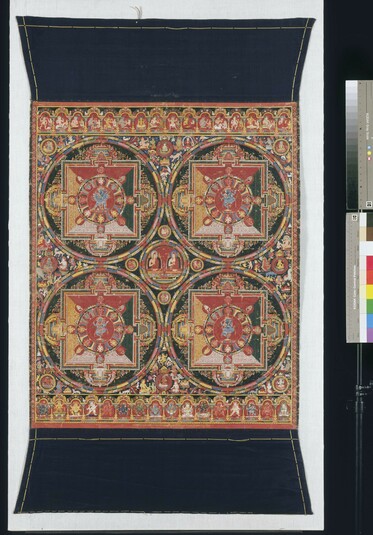
Item: Mandala of Hevajra (Buddhist Deity) - (Samputa Tantra)
| Origin Location | Tibet |
|---|---|
| Date Range | 1400 - 1499 |
| Lineages | Sakya, Ngor (Sakya) and Buddhist |
| Material | Ground Mineral Pigment on Cotton |
| Collection | Philadelphia Museum of Art |
Hevajra in four different iconographic forms based on the Samputa Tantra System, from a set of Vajravali mandala paintings commissioned by Ngorchen Kunga Zangpo in the 15th century. The set of [paintings was commissioned and created at Ngor Ewam Monastery in Tsang, Tibet, however the artists were Newari from Kathmandu Valley and the style of the paintings is pure Newari.
"...Shri Hevajra with a body blue in colour, eight faces, sixteen hands and four legs. The main face is blue, right white, left red, upper face smoky; the two remaining pairs of faces are black. Each face has three eyes and four bared fangs; yellow hair flowing upwards; the top of the head is marked with a vishvavajra. The sixteen hands hold sixteen skullcups. The first right holds a white elephant, the first left holds the yellow God of Earth; these two embrace the Mother. In the second right is a blue horse; third - ass with a white patch; fourth - yellow bull; fifth - ash-coloured camel; sixth - red man; seventh - blue sharabha; eighth - cat with a white patch. In the second left hand is the white God of Water; third - red God of Fire; fourth - green God of Air; fifth - white God of the Moon; sixth - red God of the Sun; seventh - blue Yama; eighth - yellow Holder of Wealth. Each head has a crown of five dry human skulls; and a necklace of fifty fresh heads; six bone ornaments; the two right legs are extended, on the thighs the toes of the two folded left legs are pressing in the half-[vajra] posture in a dancing manner; possessing the nine sentiments of dancing: grace, strength and ugliness; laughter, ferocity and frightful; compassion, fury and peace. In the lap is the mother Vajra Nairatmya, with a body blue in colour, one face, two hands, three eyes; yellow hair flowing upwards; right a curved knife, left holding a skullcup and embracing the father; five dry human skulls as a crown; a necklace of fifty dry [skulls]; five bone ornaments; left leg extended and the right drawn up embracing the father. Both are standing in the middle of a blazing fire of pristine awareness." (Ngagwang Legpa).
"...in the east black Gauri, right hand holding a curved knife, left a rohita fish; south red Chauri, right hand holding a damaru, left a pig; west yellow Vetali, right hand holding a tortoise, left a skullcup; north green Ghashmari, right hand holding a snake, left a skullcup; north-east blue Pukkashi, right hand holding a lion, left an axe; south-east white Shavari, right hand holding a monk, left a monk's staff; south-west purple Chandali, right hand holding a wheel, left a plough; north-west multi-coloured Dombini, right hand holding a vajra, left a wrathful gesture. Also, all have one face, two hands, three eyes and yellow hair flowing upward; naked, adorned with five ornaments of bone; a crown of five human skulls and a necklace of fifty skulls. With the left leg extended and the right in a half-lotus posture, in a dancing manner, they stand in the middle of a blazing fire of pristine awareness." (Konchog Lhundrub).
Jeff Watt, 8-2010
Mandala: Four Mandala Composition
Textile: Composition & Finishing
Textile: Mounts (Early Style)
Textile: Finishing (Textile Mounts)
Painting Set: Vajravali (Ngorchen Kunga Zangpo)
Collection of Philadelphia Museum of Art (Sakya Masterpieces)
Collection of Philadelphia Museum of Art: Nepalese Painting
Collection of Philadelphia Museum of Art (Masterworks)
Buddhist Deity: Hevajra, Two-Armed (Mandala)
Collection of Philadelphia Museum of Art: Mandala (Masterworks)
Collection of Philadelphia Museum of Art: Nepal (Painting Masterworks)
Collection of Philadelphia Museum of Art: Sakya Mandalas
Collection of Philadelphia Museum of Art
Buddhist Deity: Hevajra Mandala (Masterworks)
Collection of Philadelphia Museum of Art: Mandala Paintings
Collection of Philadelphia Museum of Art: Sakya Tradition

